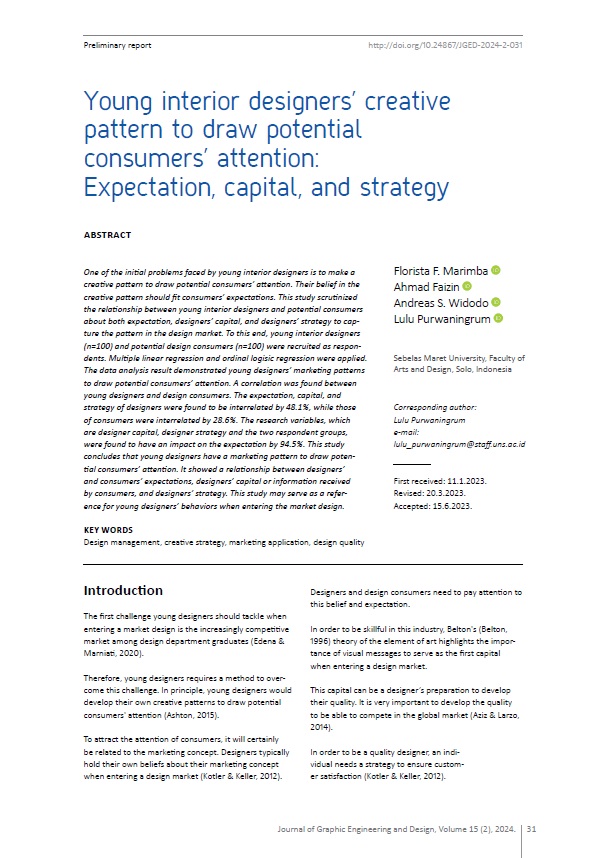Young interior designers’ creative pattern to draw potential consumers’ attention: Expectation, capital, and strategy

Published 2024-06-01
abstract views: 984 // Full text article (PDF): 334
Keywords
- Design management,
- creative strategy,
- marketing application,
- design quality
How to Cite
Abstract
One of the initial problems faced by young interior designers is to make a creative pattern to draw potential consumers’ attention. Their belief in the creative pattern should fit consumers’ expectations. This study scrutinized the relationship between young interior designers and potential consumers about both expectation, designers’ capital, and designers’ strategy to capture the pattern in the design market. To this end, young interior designers (n=100) and potential design consumers (n=100) were recruited as respondents. Multiple linear regression and ordinal logisic regression were applied. The data analysis result demonstrated young designers’ marketing patterns to draw potential consumers’ attention. A correlation was found between young designers and design consumers. The expectation, capital, and strategy of designers were found to be interrelated by 48.1%, while those of consumers were interrelated by 28.6%. The research variables, which are designer capital, designer strategy and the two respondent groups, were found to have an impact on the expectation by 94.5%. This study concludes that young designers have a marketing pattern to draw potential consumers’ attention. It showed a relationship between designers’ and consumers’ expectations, designers’ capital or information received by consumers, and designers’ strategy. This study may serve as a reference for young designers’ behaviors when entering the market design.
Dimensions Citation Metrics
References
- Ashton, D. (2015) Creative work careers: pathways and portfolios for the creative economy. Journal of Education and Work. 28 (4), 388–406. Available from: doi: 10.1080/13639080.2014.997685
- Aziz, F. & Larzo, D. (2014) Proposed Business Strategy and Developing Viral Marketing Strategy for Interior Design Business Start-Up (Case Study: artspacie). The Indonesian Journal of Business Administration. 3, 1214–1236.
- Belton, R. J. (1996) Art History: a Preliminary Handbook. Vancouver, University of British Columbia.
- Edena, Y. & Marniati, S. E. (2020) FASHION DESIGN PORTFOLIO: MODAL UNTUK BEKERJA DI MASA DEPAN. e-Journal. 9 (2), 47–56.
- Haddad, R. (2014) Research and Methodology for Interior Designers. Procedia - Social and Behavioral Sciences. 122, 283–291. Available from: doi: 10.1016/j.sbspro.2014.01.1343
- Hendriyani, H., Nuzuliya Inayati, A. & Regiasty, F. (2022) The Effect of Technology in The Development of Interior Design in Today’s Digital Age. International Journal of Design. 2 (1), 15–20. Available from: doi: 10.34010/injudes.v2i0.7341
- Izadpanah, S. & Gunce, K. (2021) Social Media as a Means of Increasing Non-Designers’ Insight into Interior Design. The Design Journal. 24 (4), 547-566. Available from: doi: 10.1080/14606925.2021.1912904
- Kim, J. & Heo, W. (2021) Interior design with consumers’ perception about art, brand image, and sustainability. Sustainability. 13 (8), 1–20. Available from: doi: 10.3390/su13084557
- Kotler, P. & Keller, K. L. (2012) Marketing management. 14th edition. London, Pearson. Miles, B. M. & Huberman, A. M. (1992) Analisis Data Kualitatif Buku Sumber tentang Metode - Metode Baru. Jakarta, UI-Press.
- Oscario, A. & Zahra, A. (2018) Strategi Penyajian Portofolio Desain. Jurnal Dimensi DKV Seni Rupa dan Desain. 3 (1), 91. Available from: doi: 10.25105/jdd.v3i1.2850
- She, L. (2021) Application Strategies of Digital Technology in the Teaching of Interior Design. Journal of Contemporary Educational Research. 5 (10), 53–56. Available from: doi: 10.26689/jcer.v5i10.2602
- Taylor, D. G. & Strutton, D. (2010) Has e-marketing come of age? Modeling historical influences on post-adoption era Internet consumer behaviors. Journal of Business Research. 63 (9–10), 950–956. Available from: doi: 10.1016/j.jbusres.2009.01.018
- Wong, S. C., Zaffwan Idris, M. & Tan, W. C. (2021) Identifying competencies for future graphic design graduates in malaysia: A delphi study. Journal of Graphic Engineering and Design. 12 (3), 13–23. Available from: doi: 10.24867/JGED-2021-3-013


